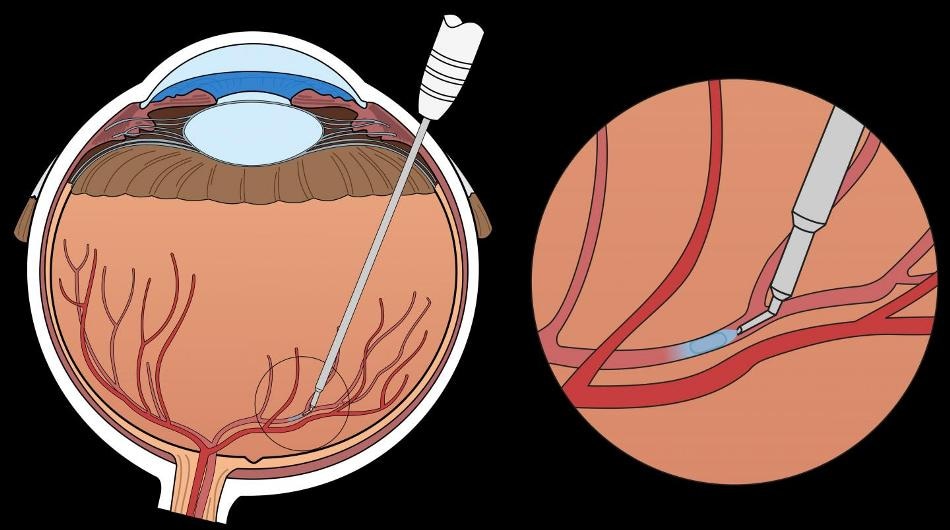Jan 27 2017
Eye surgeons at University Hospitals Leuven have been the first to use a surgical robot to operate on a patient with retinal vein occlusion. The robot uses a needle of barely 0.03 millimetre to inject a thrombolytic drug into the patient’s retinal vein. KU Leuven developed the robot and needle specifically for this procedure.
 Surgeons of University Hospitals Leuven have been the first to operate on a patient with retinal vein occlusion using a surgical robot. Operated by an eye surgeon, the robot uses a needle of barely 0.03 millimetre to inject a thrombolytic drug into the retinal vein of the patient. KU Leuven (University of Leuven, Belgium) developed the robot and needle specifically for this procedure. (Credit: KU Leuven)
Surgeons of University Hospitals Leuven have been the first to operate on a patient with retinal vein occlusion using a surgical robot. Operated by an eye surgeon, the robot uses a needle of barely 0.03 millimetre to inject a thrombolytic drug into the retinal vein of the patient. KU Leuven (University of Leuven, Belgium) developed the robot and needle specifically for this procedure. (Credit: KU Leuven)
The operation was successful and is a world first. It shows that it is technically possible to safely dissolve a blood clot from the retinal vein with robotic support. A phase 2 trial now has to show what the clinical impact is for patients with retinal vein occlusion, a disorder that can lead to blindness.
Patients with retinal vein occlusion have a blood clot in one of the retinal veins. This leads to reduced eyesight or even blindness in the affected eye. At the moment, treatment consists of monthly injections in the eye that only reduce the side effects of the thrombosis. Until recently, taking away the blood clot itself was not possible.
Researchers from University Hospitals Leuven and KU Leuven are studying retinal vein cannulation (RVC), a revolutionary treatment that addresses the cause of retinal vein occlusion by removing the blood clot in the retinal vein. RVC is a promising method that requires the eye surgeon to insert an ultrathin needle into the vein and inject a medicine to dissolve the blood clot. This is a real feat, because a retinal vein is only 0.1 millimetre wide – similar to a human hair. No surgeon is able to manually inject a drug into such a thin vein while holding the needle perfectly still for 10 minutes. The danger of damaging the vein or the retina would simply be too high.
Eye Surgery Robot
This is why researchers from the KU Leuven Department of Mechanical Engineering developed a robotic device that enables the surgeon to insert the needle into the veins in a very precise and stable way. Once the needle is inserted, the robot can hold it perfectly still.
Unlike most surgical robots, there is no need for a joystick to operate the device. The eye surgeon and the robot co-manipulate the instrument. The surgeon guides the needle into the vein while the robot eliminates any vibration of the needle, thereby increasing the level of precision more than tenfold. After locking the robot, the needle and the eye are automatically stabilised. The surgeon can then inject the product into the vein in a controlled way.
The researchers also found a way to produce an ultrathin injection needle: the needle point is barely 0.03 millimetres wide – three times thinner than a human hair.
The robot is the result of seven years of research and a collaboration between KU Leuven engineers and University Hospitals Leuven ophthalmologists. The current phase 1 trial aims to demonstrate that it is technically feasible to use a robotic device to insert a microneedle into the retinal vein and to inject the product Ocriplasmin to dissolve the blood clot.
On 12 January 2017 the procedure was performed for the first time on a University Hospitals Leuven patient. The patient is doing well and can now start working on the rehabilitation of the eye. In a subsequent phase 2 trial the physicians will study the clinical effects of the procedure.
“The current treatment for retinal vein occlusion costs society €32.000 per eye,” says Professor Peter Stalmans, eye surgeon at University Hospitals Leuven. “This is a high price tag, considering that you’re only treating the side effects and that there is little more you can do than avoid reducing eyesight. The robotic device finally enables us to treat the cause of the thrombosis in the retina. I look forward to what is next: if we succeed, we will literally be able to make blind people see again.”
“We are extremely proud that our robot enables us to perform eye surgery that was previously impossible to perform safely,” adds Professor Dominiek Reynaerts from the KU Leuven Department of Mechanical Engineering. “This brings us one step closer to commercialising this ground-breaking technology. We look forward to making other revolutionary procedures possible with this robotic device and to improving the quality of existing surgical treatments.”
Worldwide there are 16.4 million people with a blocked retinal vein caused by thrombosis in the blood vessel. In Belgium, there are about 25.000 patients.
Source: https://www.kuleuven.be/